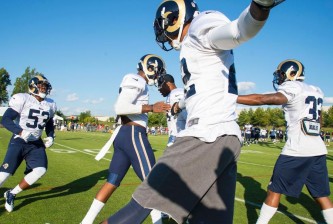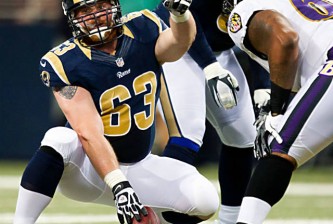Week 1: Rams (0-0) at Seahawks (0-0)
![]() 0
0 ![]() 28
28
NFL.com: Recap | Play by Play | Video
| Week | Date | Opponent | LY: Record | LY: Points | 3Y: Record | 3Y: Points |
| 1 | Sep. 13 | at Seattle Seahawks | 4-12 | 294/392 | 23-25 | 1022/1024 |
| Rams games vs opponent, last three seasons: | ||||||
| Week 6, 2006: Lost 28-20 at home Week 10, 2006: Lost 24-22 in Seattle Week 7, 2007: Lost 33-6 in Seattle Week 12, 2007: Lost 24-19 at home Week 3, 2008: Lost 37-13 in Seattle Week 15, 2008: Lost 23-20 at home | ||||||
Supposedly inscribed above the gates of Hell: “Abandon All Hope, Ye Who Enter Here.” The same could have been written above the entrance to the 2009 Rams season. The greatest heroic journeys ever told, though, are of heroes like Perseus and Orpheus who did venture into Hell, and came out the other side.
Donnie Avery must have been a beast in rehab, striving to come back in time for Game 1 from a broken bone in his toe suffered early in the preseason. His hard work was rewarded by the Rams coaches, who gave him the opportunity for the first touch of the Rams season, working as kick returner. This small story of redemption ended bitterly just two seconds later, as Avery tentatively crept inside his wedge looking for a seam, got blasted, and fumbled.
For a team looking to build a culture of optimism, a culture of rebirth and redemption, this season had no end of these types of mini-tragedies. It’s to the credit of coach Spagnuolo that he kept his young team’s heads up, kept them fresh and fighting all the way through to December’s end.
Some trends that would bedevil the Rams throughout the season became immediately apparent:
- “Creativity” in offensive formations that seemed to confuse the offense more than the defense. In the Rams’ scripted first 15 plays, they came out with an unbalanced line, moving Jason Smith to left-left tackle to create an overload, and lining up McMichael on the right. They tried a rare play action, but only sent two receivers into the pattern. They lined up Mike Karney in the “X” receiver spot, then tried to bring him back into the scrum to run-block. Combined, these three plays went for two yards.
- Bad penalties, obviously. Richie Incognito jumps early on the Rams’ first offensive play, then racks up 30 yards of negative yardage on personal fouls. With the game still scoreless, Donnie Avery negates a first-and-ten inside the Seahawks 15 with a block in the back. Rams penalize themselves backwards from the 11 into a missed field goal.
- Outside containment on running plays & screens. For all the brouhaha regarding the Rams’ defensive tackles, and plans to draft Ndamukong Suh, the Rams did a decent job defending runs inside the box. But anything to the outside — running away from whichever direction Laurinaitis was shaded — found the tender white meat of the Rams’ defense — the lack of side to side speed of David Vobora and Will Witherspoon and tendency for James Butler to get caught out of position often left them grasping at air. This same weakness manifests into an inability to cover tight ends and slot receivers, a trend that worked strongly against the Rams all season long.
- Rams “shooting themselves in the foot.” This phrase became a season-long mantra, but I hadn’t realized that it was a direct quote from Spags in his sideline interview, coming out of the first half.
Some other observations:
- If OJ Atogwe and Jonathan Wade played all year the way they played in the first quarter of this game, they’d both still be Rams today. Wade nearly erased Nate Burleson with in-the-shirt coverage and good eyes for the football. Atogwe, meanwhile, batted down a bullet in the end zone, and was involved in two turnovers including a brilliant pick from the “center field” position, jumping inside a curl route to Burleson from five yards behind the play. The Rams kept it close in the first half thanks to turnovers like this — three in the first quarter alone.
- The Rams’ offense severely lacked timing, and it wasn’t just crowd noise. Much of Shurmur’s schemes depend on offensive screens — springing inside screens to Jackson after sucking up the front four, or bubble screens to receivers in desperate attempt to generate space. But the timing was way off, way way off in this first game. Bulger threw too early or receivers turned around too late, or blockers arrived to late or not at all.
-
Spagnuolo sacrifices momentum for the sake of small positive outcomes. The theme for the 2009 season has been all about generating small victories, tiny building blocks of confidence. But this mentality leads to many conservative decisions that negate his own team’s momentum.
At the end of the first quarter, game still scoreless, the Rams offense begins to click, with a brilliant effort on an end around by Avery and a nice throw and catch to generate a second-and-two from the Seattle 21. The Seattle defense is on its heels, and this is a favorable down and distance to try a throw into the end zone. Instead of going for the throat, though, the coach lets nearly 15 seconds tick off the clock to end the quarter on a “positive note” and allow Seattle’s defense — and their 12th man in the stands — to regroup. The drive grinds to a halt at the 11, the Rams push themselves back on consecutive plays, unable to cleanly snap the ball, and Josh Brown misses a field goal in the Rams’ best scoring chance of the day.
I’m not saying that many other coaches wouldn’t do exactly the same thing in this scenario, trusting their team to make plays regardless of the clock, but the Rams seemed consistently to be a step behind the Seahawks when coming out of any kind of timeout. Momentum was one of the few weapons working in our favor, but our ballcoach didn’t seem to recognize it.
Conversely, the Seahawks rode their own momentum well, generating scoring in spurts when they had the Rams defense — which played feisty and competitively on most drives, despite the game outcome — crossed up.
- The Rams tried to throw deep, but Bulger couldn’t make the throws. For all the fan frustration with the Rams inability to make their “timing offense” work, all the eight- and nine-man defensive fronts we faced, there was one simple prescription: air the damn ball out. But there was one problem with this, and it wasn’t the receivers — Bulger just didn’t have the arm any more to make the deep throw. He consistently underthrew receivers deep all season long, allowing the defense backs to cover underneath and make plays, even if they got beat deep.
The open question facing the Rams coming into 2010 will be how much improvement they can show coming out of the gate — improvements in timing, in discipline, and taking advantage of the momentum in those rare occasions when the ball is bouncing their way. The new season opens at home against the new-look Arizona Cardinals.























